We may receive a commission when you use our affiliate links. However, this does not impact our recommendations.
 Editor’s note: In recognition of a fascinating new documentary on the work of Wharton Esherick, by Carolyn Coal, we’re sharing this article from the Winter 2011 issue of Woodwork Magazine. Find out more about the film, watch the trailer and order your copy at WhartonEsherickDocumentary.com.
Editor’s note: In recognition of a fascinating new documentary on the work of Wharton Esherick, by Carolyn Coal, we’re sharing this article from the Winter 2011 issue of Woodwork Magazine. Find out more about the film, watch the trailer and order your copy at WhartonEsherickDocumentary.com.
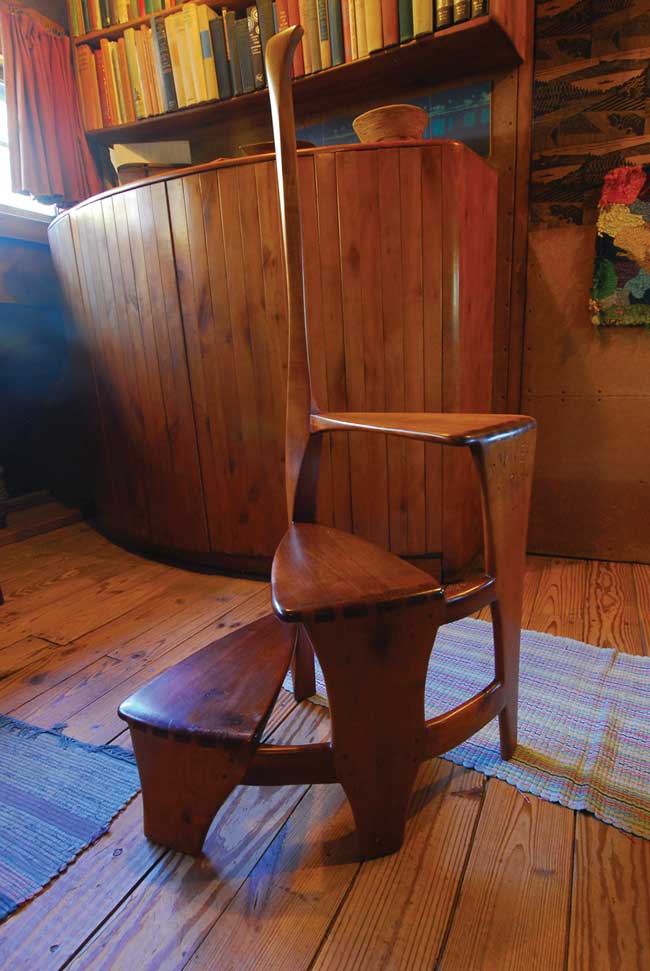
by Mark Sfirri
from the Winter 2011 issue of Woodwork Magazine
Several years ago I was talking to Edward S. Cooke, Jr., the Charles F. Montgomery Professor of American Decorative Arts at Yale University, on the subject of Wharton Esherick (1887-1970). Cooke mentioned that Esherick, who began his woodworking in 1920 and is considered the progenitor of the American studio furniture movement, had inspired other woodworkers to make music stands, and cited the Woodenworks exhibition of 1972 (1) as evidence. Woodenworks was the inaugural exhibition at the Renwick Gallery of the Smithsonian Institution in Washington, D.C. A look back at the show provides a snapshot of a time in the creative lives of five wood-workers who were to be leading influences in the development of American studio furniture. The five were Esherick, Arthur Espenet Carpenter (1920-2006), Sam Maloof (1916-2009), Wendell Castle (1932-) and George Nakashima (1905-1990). I was lucky enough to have seen that exhibition and had images of the pieces included in it, so I went back and looked at them. Sure enough, there were four music stands in the show, one each by Esherick, Carpenter, Maloof and Castle. They seemed like such obvious nods to Esherick that I was surprised that I hadn’t noticed it earlier. Cooke attributes their choice of subject to the interconnection at the time of craftspeople and other sorts of artists, especially musicians.
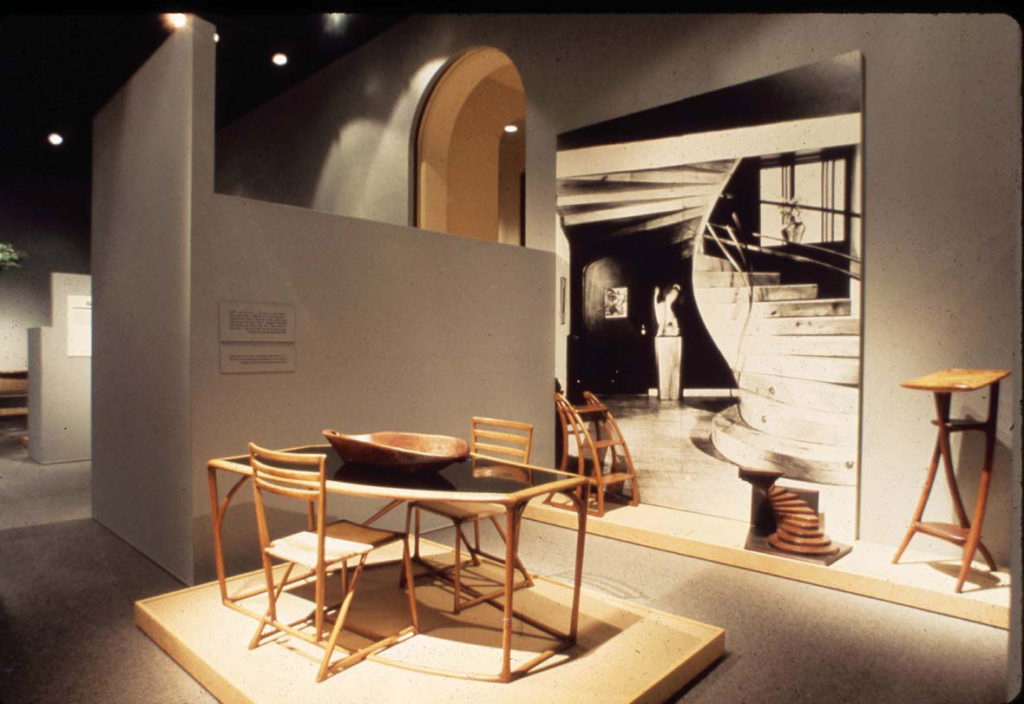
Esherick’s pieces on display at Woodenworks, 1972. Woodenworks, sponsored jointly by the Smithsonian Institution and the Minnesota Museum of Art, was the inaugural exhibition at the Renwick Gallery of the National Collection of Fine Arts in Washington, D.C. Photo courtesy of the American Craft Council Library Slide Study Collection.Opposite page: Wharton Esherick, Single Music Stand (1951); walnut; 44-1/4″ x 19-7/8″ x 19-3/4″. Photo by Mark Sfirri.
Wharton Esherick’s iconic Single Music Stand (above) was not included in Woodenworks (a later, double music stand, shown below, was), but it is essential to examine this stand first in order to understand Esherick’s influence. Examples of it are in the permanent collections of a number of important museums, including the Metropolitan Museum of Art and Yale University Art Gallery. It was commissioned in 1951 by Rose and Nat Rubinson, who kept it in their house, where it remained largely unseen until its appearance at the 1958 Brussels World’s Fair. An image of the stand appeared in the May/June 1958 issue of Craft Horizons magazine, the forerunner of American Craft, in an article about American craft included in the Fair. It also appeared in Esherick’s major retrospective at the Museum of Contemporary Craft (later the American Craft Museum, and now Museum of Art and Design) in 1958 in New York City.
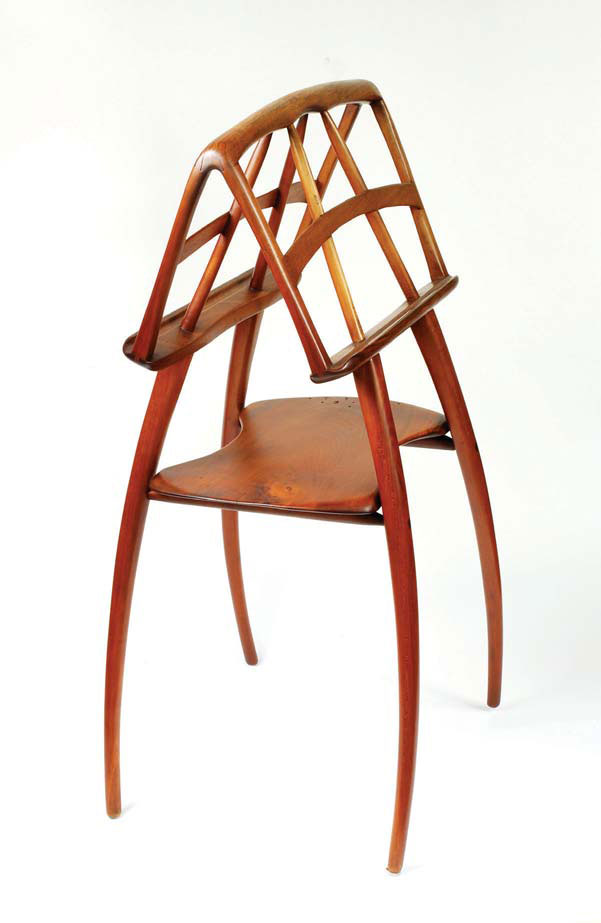
Wharton Esherick, Double Music Rack (1962); walnut and cherry; 39″ x 21″ x 17-1/2″. Photo by Mark Sfirri.
Esherick was an artist who worked and experimented in more than one medium. He was a painter, printmaker and sculptor, as well as a furniture maker, and there were more hits and misses in his work than there might have been in the career of someone who follows a narrower path. As important an object as this music stand has become, it was his first effort and it does have flaws. Its curved front legs end abruptly at the horizontal element where the sheet music rests. The line of the front legs continues with several small vertical dowels, which don’t allow the line to flow. The upper frame that holds the music is disproportionately large compared to the base. It appears to be leaning forward and turns out to be tippy, too. (The lower shelf is structural, but was also intended to provide a spot for Mrs. Rubinson’s drink while she played her cello.) The stand has the softened edges and curved elements typical of much of Esherick’s work. The stand exhibited in Woodenworks was his later Double Music Rack, one of only two or three double stands that he made. The scale of this stand’s upper frame is much more in keeping with the size of the base, and it’s stable. It’s also smaller than the original single stand. Visually, the double stand (2) is more successful.
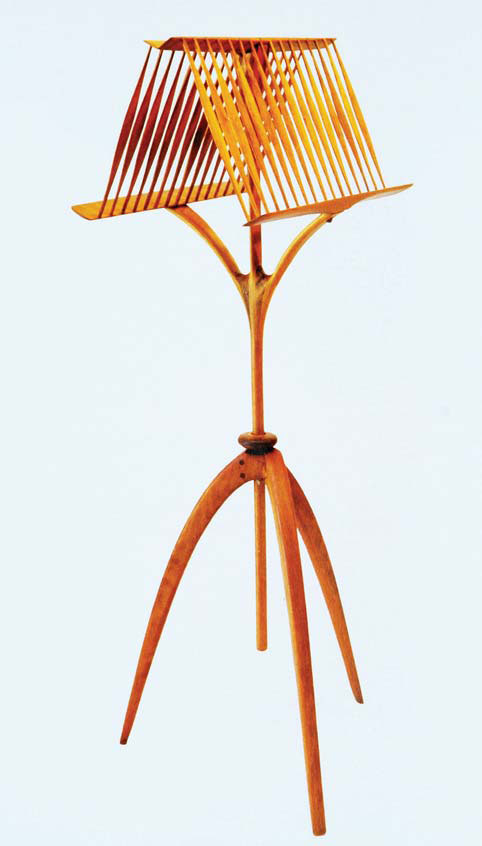
Arthur Espenet Carpenter, Double Music Stand, (1968; design introduced 1961); cherry and walnut, 54″– 68″ x 21″ x 13″. Photo by Art and Tripp Carpenter.
Art Carpenter’s music stand that appeared in Woodenworks used design elements that also appeared in tables that he was making at the time. There is an earthy, primitive look to Carpenter’s stand that is characteristic of his work. The four curving legs, perched like a spider’s, do not meet tidily mitered together around the vertical stem. Unlike Esherick’s stand, the base elements are separated from the upper portion. The vertical column and two branches curve out to support the upper section. It isn’t graceful but it has a vibrating energy. In some subsequent stands, the vertical elements that support the music pierce the top and bottom crosspieces, emphasizing this effect.
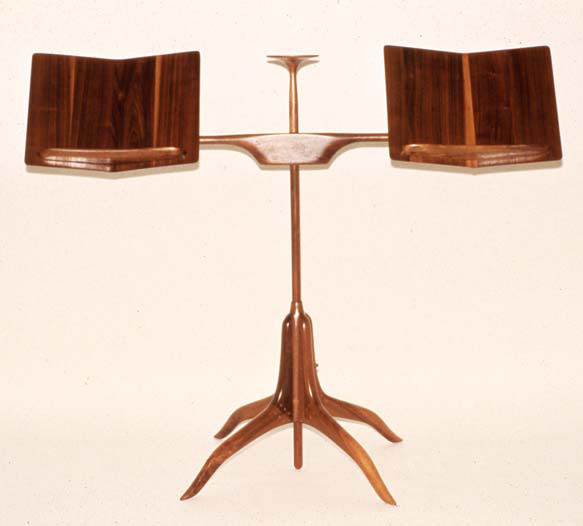
Sam Maloof, Double Music Rack, (1971; design introduced 1960); walnut, 44-1/2″ x 48″ x 30″. Photo courtesy of the American Craft Council Library Slide Study Collection.
Sam Maloof’s furniture falls into two general categories. His chairs — the work most people associate with him — are his most sculptural work, characterized by sweeping curves and shaped elements with crisp lines of definition reminiscent of Art Nouveau. The second category, his case goods and tables, comprises mostly pieces constructed from two-dimensional cutouts with rounded over edges. His Double Music Rack falls more into this latter category. The base is delicate, but even though the two racks are better proportioned than Esherick’s first design, the use of solid wood panels to support the music makes it appear top-heavy.
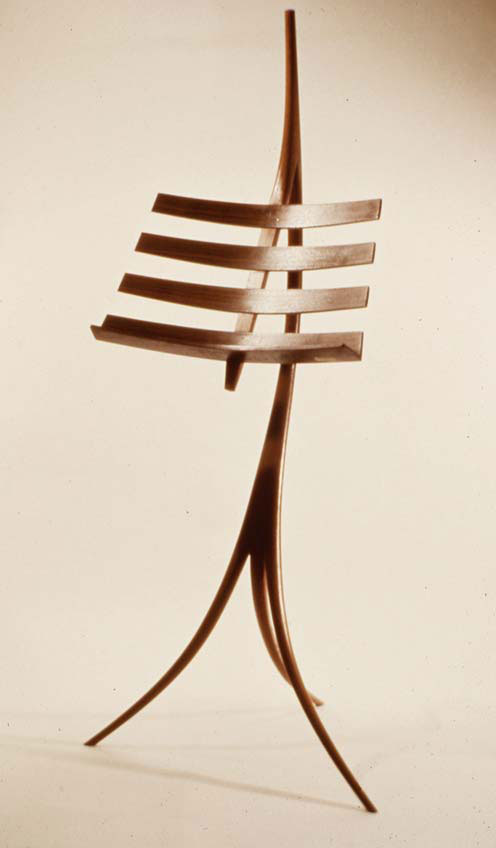
Wendell Castle, Music Rack, (1964; design introduced 1963); 56″ x 18″ x 21″. Photo courtesy of the American Craft Council Library Slide Study Collection.
Unlike the music stands of Carpenter and Maloof, Esherick’s and Wendell Castle’s cannot be adjusted for height or angle of tilt. At the time that he made his stand in 1963, Castle was mainly producing sculptural, stack-laminated furniture, work that is relatively heavy visually. He took a different approach with his Music Rack. Its slender bent wood parts allow for lightness, creating a harmonious composition that sweeps up to the top and then curves back down to present a lightweight support to hold the music. The form has a lyrical quality very expressive of the concept of music. If ever there were a piece that embodied function in form, this is it.
Wondering what Castle and Maloof thought about the idea that Esherick had influenced their music stands, I spoke to them both in 2007. Castle said that he didn’t recall seeing one of Esherick’s music stands before he designed his. He explained that his wife at that time was a classical musician and he made music stands for her and several of her friends. Castle certainly acknowledged Esherick’s general influence, however, in the catalog for Woodenworks and in the August 1970 issue of Craft Horizons, where he wrote a tribute to Esherick, who had died in May of that year. Castle wrote: “I paid little attention to furniture as a mode of expression until 1958 when I discovered Esherick’s work. It came about through reading the book “Shaping America’s Products” by Don Wallance (Reinhold Publishing Corporation, 1956). One person’s work in that book changed my entire thinking about furniture. That person was Esherick … It had never occurred to me that furniture could be anything so personal and so powerful as sculpture. Seeing those photographs of Esherick’s furniture began my involvement.”
I asked Sam Maloof if the idea of making a music stand might be traced to Esherick, but he answered no, firmly. He claimed that Esherick had no influence on any of his designs. However, in the book “The Furniture of Sam Maloof “by Jeremy Adamson (Smithsonian American Art Museum, W. W. Norton & Company, 2001) there is a reference to the shaped arms of Maloof’s early chairs: “The early arms’ plasticity, however, was relative — especially to Wharton Esherick, a dedicated carver and sculptor of wood. In the early summer of 1958, Maloof sent the Pennsylvania woodworker a set of his stereo slides for review. The older craftsman later returned them with a note: ‘I wish that some of your things would have a little more sculptural quality.’ In years to come, Maloof would take Esherick’s suggestion to heart” (page 85). “Music racks were woodworkers’ showpieces. Wharton Esherick had been among the earliest to create one … (Maloof had seen his curvaceous version at Esherick’s retrospective in New York on his way to the Middle East … )” (page 123). This certainly suggests that Esherick influenced Maloof, but, like Castle, in a general sense.
Lastly, in Art Carpenter’s autobiographical book, arthur espenet carpenter: education of a woodsmith (Bubinga Press, 2010), a chapter titled “Influence” acknowledges Esherick as a source. Carpenter states: “ … there was Hans Wegner and Wharton Esherick, who created hand-crafted work … allied with my processes — the crafter’s processes. Their work became a(n) … inspiration to me so I was influenced early on by them.”
Esherick’s music stand transcended the utilitarian or traditional designs of the past, inventing an altogether original interpretation of this functional object. His desire to bring sculpture into furniture, to create a music stand as a beautiful object, is what inspired the others. Each of theirs has design elements that reflect its maker exclusively, but Esherick was the first with a new idea. His music stand predated theirs by a decade and was featured in a national publication and in a major exhibition before the others were conceived. When Esherick combined personal expression with furniture design early in the twentieth century and in a career of more than four decades, he influenced not only the makers of the succeeding generation, but those embarking on studio furniture careers today, whether or not that influence is apparent to them.
All issues of Woodwork Magazine are available on one DVD, at ShopWoodworking.com.
Here are some supplies and tools we find essential in our everyday work around the shop. We may receive a commission from sales referred by our links; however, we have carefully selected these products for their usefulness and quality.









